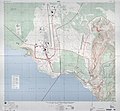20th century
| History of the Democratic Republic of the Congo | ||||||||||||||||
|---|---|---|---|---|---|---|---|---|---|---|---|---|---|---|---|---|
 | ||||||||||||||||
| ||||||||||||||||
| ||||||||||||||||
| ||||||||||||||||
| See also: Years | ||||||||||||||||
- 1910 - Goma confirmed as a Belgian possession in the Convention on the Lakes signed in Brussels on 14 May 1910 by plenipotentiaries of Belgium, Germany, and Great Britain. [1]
- 1925 - Albert National Park established near Goma.
- 1959 - Roman Catholic Diocese of Goma founded. [2]
- 1962 - Benezeth Moley becomes governor.(fr)
- 1984 - Population: 77,908. [3]
- 1988 - Goma becomes part of newly formed North Kivu province.[ citation needed ]
- 1993 - University of Goma established.
- 1994
- Population: 161,956. [4]
- July: 850,000 Rwandan war refugees flee to Goma. [4] [5]
- 1996 - 2 November: Goma taken by Alliance of Democratic Forces for the Liberation of Congo. [5]
- 1998 - 2 August: City taken by forces of Rally for Congolese Democracy–Goma. [4]
- 2000
- Yole!Africa cultural centre established. [6]
- Eugène Serufuli Ngayabaseka becomes governor of North Kivu province.(fr)







